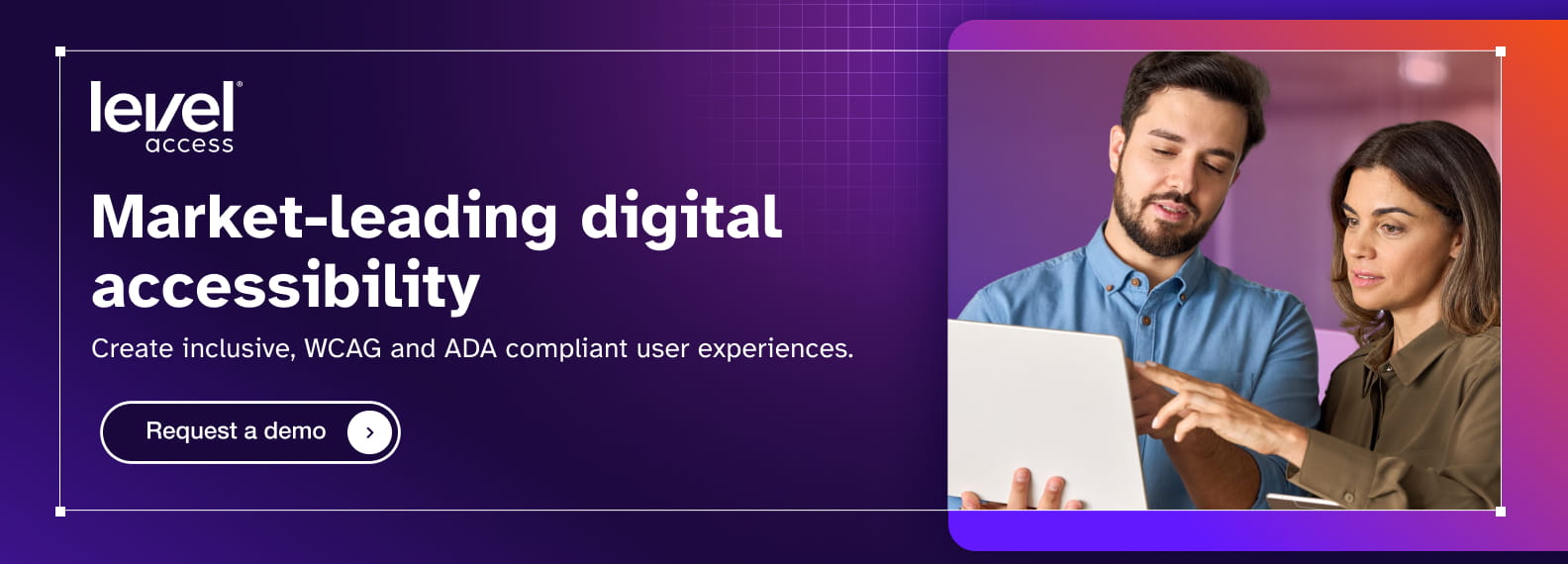The laws and standards relating to digital accessibility can be complex, whether your organization operates in the public or private sector. You may be aware of digital accessibility requirements under the Americans with Disabilities Act (ADA) and Section 508 of the Rehabilitation Act or have come across information about the Web Content Accessibility Guidelines (WCAG). But how do these laws and standards fit together? And which are relevant for your organization?
In this article, we break down ADA compliance vs. Section 508 compliance vs. WCAG conformance to help you understand your responsibilities when it comes to digital accessibility regulations.
ADA vs. Section 508 compliance: What’s the difference?
The Americans with Disabilities Act, or ADA, is a U.S. civil rights law passed in 1990 that protects people from discrimination based on disability. The ADA’s five titles apply to different types of organizations and mandate equal access to various aspects of public life, including education, employment opportunities, and public services. With regard to web accessibility, the two titles that are most frequently referenced are Title II and Title III.
Title II of the ADA mandates the accessibility of state and local government programs and services, and now includes specific requirements for web and mobile app accessibility. Meanwhile, Title III of the ADA prohibits discrimination in “places of public accommodations.” While web accessibility is not explicitly mentioned in its language, the U.S. Department of Justice (DOJ) and individual courts have interpreted Title III to apply to digital content, not just physical spaces. This means if your web content is not accessible, you can face an ADA discrimination lawsuit.
Section 508 of the Rehabilitation Act of 1973 (often referred to simply as “Section 508”) is a U.S. federal law that requires federal agencies to create, purchase, and use information and communications technology (ICT) that is accessible to people with disabilities. Its application is narrower than the ADA’s, in that it applies primarily to federal agencies and departments, ensuring that all people, regardless of disability, can benefit from federal agency resources.
Section 508 also indirectly impacts organizations doing business with federal agencies, as these organizations must meet the law’s requirements to sell their products. A closely related section of the Rehabilitation Act, Section 504, covers entities that receive federal funding, such as schools, universities, hospitals, and nursing homes.
Consequences of ADA vs. Section 508 non-compliance
ADA non-compliance can result in reputation-damaging lawsuits and costly legal fees. Meanwhile, non-compliance with Section 508 can result in loss of funding for federal agencies. For vendors who sell digital products to federal agencies, failing to meet Section 508 requirements may jeopardize contracts with those agencies.
Of course, the most significant consequence of non-compliance with the ADA or Section 508 is the exclusion of people with disabilities from access to online goods and services. And for businesses, excluding this consumer base has a price: people with disabilities, along with their friends and family, control over $13 trillion in spending globally.
So, how do you make sure your websites, software, apps, and other digital content can be accessed by all? The gold standard for web accessibility is the Web Content Accessibility Guidelines, or WCAG.
Achieving compliance: WCAG vs. ADA vs. Section 508
WCAG provides technical specifications to improve web content accessibility for people with a wide range of disabilities, including auditory, cognitive, physical, and visual disabilities. WCAG’s success criteria are categorized into three levels: A, AA, and AAA. Each level includes and builds on the previous one, with Level A representing basic accessibility and Level AAA representing optimal accessibility.
WCAG standards don’t constitute the law, but aligning with these standards helps organizations comply with legal requirements. For instance, WCAG 2.1 AA is the compliance standard for Title II of the ADA. And while Title III of the ADA doesn’t mention WCAG explicitly, in recent years, DOJ enforcement of the ADA has cited conformance with WCAG version 2.1 at Level AA as a settlement requirement.
Additionally, Section 508 sets conformance with WCAG version 2.0 Level AA as the accessibility standard for federal organizations.
As a best practice, we recommend that organizations work toward Level AA conformance with the most recent version of WCAG, WCAG 2.2, which was released in October of 2023.
Comparative overview
Refer to the table below for an easy comparison of these laws and standards:
How Level Access helps
In the journey to an accessible web, laws like ADA and Section 508 only represent the destination. WCAG provides a roadmap to getting there, and conforming to its standards puts you well on your way to legal compliance.
So, how can you achieve WCAG conformance? The Level Access solution combines a unified platform for tracking and managing digital accessibility with manual evaluation, remediation support, legal expertise, and more. Explore our digital accessibility solution today.
The post ADA vs. 508 Compliance vs. WCAG: Learn it All Here appeared first on Level Access.
